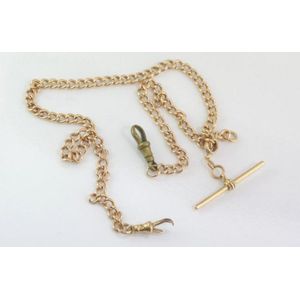18th Century Gilt Bronze Chatelaine with Watch and Thimble Holders
You must be a subscriber, and be logged in to view price and dealer details.
Subscribe Now to view actual auction price for this item
When you subscribe, you have the option of setting the currency in which to display prices to $Au, $US, $NZ or Stg.
- Bronze - An alloy of copper and tin, traditionally in the proportions of about 9 parts of copper to 1 part of tin.
The discovery of bronze in Western Asia in the 4th century enabled people to create metal objects which were superior to those previoulsy possible because of its strength and hardness, and it has been used throughout the world for weapons, coins, tools, statuary and other decorative items.
It is very fluid in a molten state, and its hardness, strength when set, and non-corrosive properties makes it most suitable for casting sculpture. - Circa - A Latin term meaning 'about', often used in the antique trade to give an approximate date for the piece, usually considered to be five years on either side of the circa year. Thus, circa 1900 means the piece was made about 1900, probably between 1895 and 1905. The expression is sometimes abbreviated to c.1900.
- Embossed / Repousse - Embossing, also known as repousse, is the technique of decorating metal with raised designs, by pressing or beating out the design from the reverse side of the object.It is the opposite of chasing, where the decoration is applied from the front. An embossed or repoussed object may have chasing applied to finish off the design.
This item has been included into following indexes:
Visually similar items

A gentleman's titanium Porche Design wristwatch, IWC. Automatic. 35 mm. Ref: 3520. Cal. 37524. Case number 2553526. Black dial with baton numerals. Case, dial, movement and original black leather strap signed. No box or papers

Large George IV architectural mahogany secretaire bookcase with arched glazed doors, circa 1830, with key to bookcase, secretaire with gilt tooled leather inlay, secret compartment, 258 cm high, 162 cm long, 59 cm deep, pelmet is upside down in first image

15ct rose gold fob chain, with broken parrot clasp and replacement clasp, total weight 27.14 grams, size 44 cm with similar sized new parrot clasps

A ladies IWC wristwatch. 18ct yellow gold, early 20th century, manual wind, marked to dial, case and movement International Watch Co. With case no 1411520, fitted with a C.431 movement in small round case, with silvered dial, baton numerals, fitted to a do
